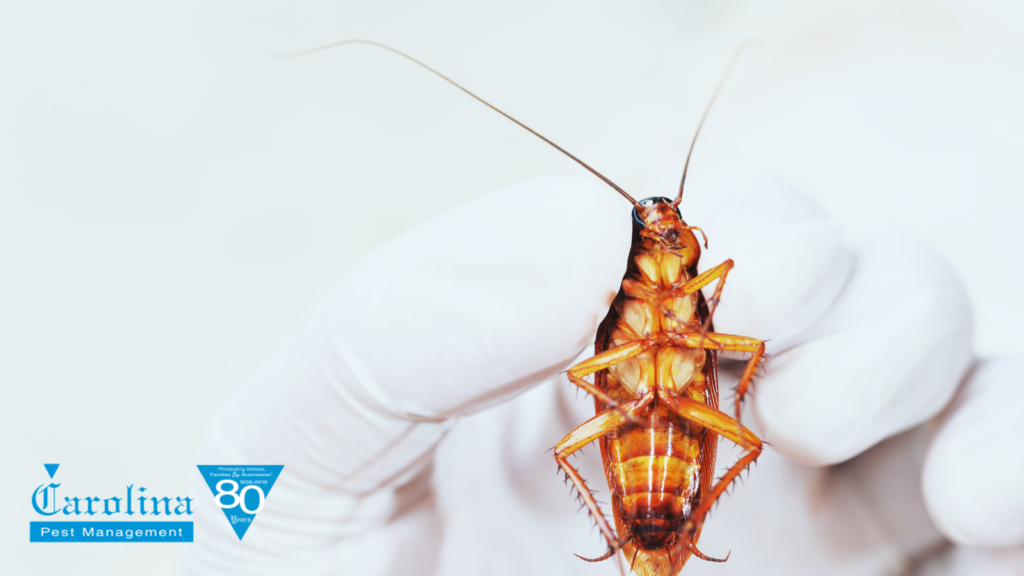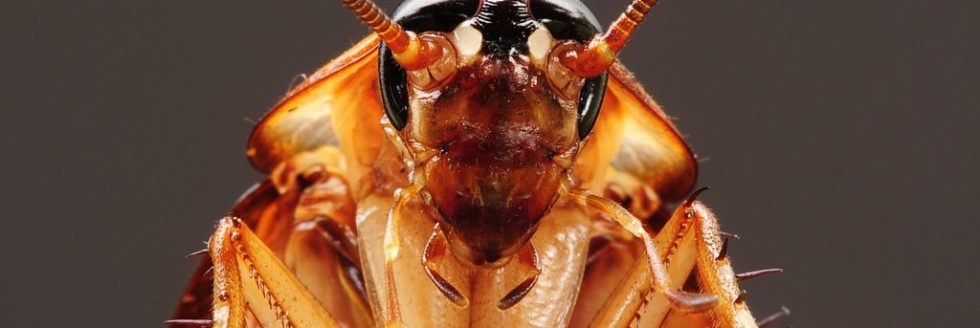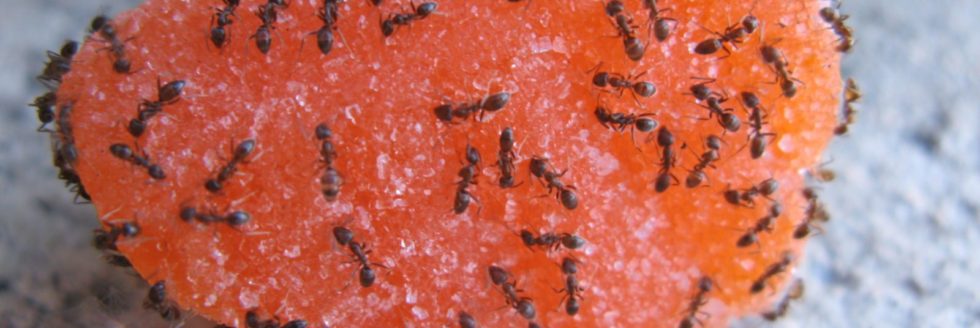How To Get Rid of Palmetto Bugs & Cockroaches
If you live in the American south, you’ve likely heard of palmetto bugs. These winged creatures infest Charlotte homes during the cooler months, causing problems like asthma and allergies.

Simply put, palmetto bugs are a nuisance. Below, we discuss the key differences between palmetto bugs and other cockroach species. We also answer a burning question: How do you get rid of palmetto bugs in Charlotte, NC?
Contents
- What Is a Palmetto Bug?
- Palmetto Bugs vs. Cockroaches: How To Tell the Difference
- Are Palmetto Bugs Dangerous?
- What Causes Palmetto Bug Infestations?
- Signs of a Palmetto Bug Infestation
- How To Get Rid of Palmetto Bugs in Charlotte, NC
- Preventing Future Palmetto Bug Infestations
What Is a Palmetto Bug?
“Palmetto bug” isn’t a scientific term. Instead, it’s a colloquial nickname for smoky brown and American cockroaches.
These cockroach species can grow up to three inches long and are usually found in the U.S. south, where they tend to nest in palmetto bushes and palm trees.
But when temperatures drop, palmetto bugs are known to take shelter in houses. Once inside, these creatures lay hundreds of eggs in kitchen cabinets, dresser drawers and even clothing.
Palmetto Bugs vs. Cockroaches: How To Tell the Difference
But are palmetto bugs any different than cockroaches?
Yes and no. According to pest control experts, the term “palmetto bug” is used to reference certain types of cockroaches, specifically the smoky-brown and American cockroaches.
With more than 70 species of cockroaches in the U.S., it can be hard to determine if you’re dealing with a palmetto bug infestation or something else. Luckily, there are important distinctions between palmetto bugs and other types of cockroaches.
Palmetto Bug vs. Cockroach: Key Differences
Size
Palmetto bugs are larger than other cockroach species. Regular roaches grow to be 0.5 to 1.5 inches in length. Comparatively, palmetto bugs can grow to be 2 to 3 inches long.
Appearance
Since the term “palmetto bug” is used to describe two different cockroach species, you have to look for two sets of characteristics. Smokybrown cockroaches have a dark-colored body with a uniform appearance. American cockroaches usually have a reddish and brown color, and they may even have light markings around their heads. Other species of cockroaches range from light brown to nearly black.
Flight
All palmetto bugs have wings. Some other species of cockroaches have wings too, while others do not.
Habitat
Palmetto bugs tend to nest in palmetto bushes and palm trees in the U.S. south. They are most common in North Carolina, South Carolina and Florida. If you see a cockroach in Charlotte, you can assume it’s a palmetto bug. Regular roaches are less choosy when it comes to habitat.
Are Palmetto Bugs Dangerous?
Just like other species of roaches, palmetto bugs can be dangerous.
Since palmetto bugs often reside in unsanitary conditions, like sewer drains and bathroom pipes, they can spread germs by crawling across dishes and counters.
These insects also carry a range of bacteria that, if deposited on food or eating surfaces, can cause:
- Salmonella
- Staphylococcus
- Streptococcus
- Dysentery
- Diarrhea
- Cholera
- Typhoid fever
Additionally, palmetto bugs can harbor deadly viruses like the polio virus.
Do Palmetto Bugs Bite?
Palmetto bugs are typically very shy creatures that quickly retreat when approached by humans. However, when threatened, they will bite. Palmetto bug bites are similar to bed bug bites but bigger and redder.
Palmetto bugs can also scratch you with their leg spines. These scratches can become infected if not cleaned properly.
Do Palmetto Bugs Cause Allergies?
Palmetto bugs and other roach species are one of the most common sources of indoor allergens.
Why? Because the body parts, saliva and waste of cockroaches contain a specific protein that causes an allergic reaction in more than 40% of people.
Common palmetto bug allergy symptoms include:
- Sneezing
- Runny nose
- Itchy, red or watery eyes
- Stuffy nose
- Itchy nose, mouth or throat
- Postnasal drip
- Cough
- Itchy skin or skin rash
In some people, palmetto bugs can also trigger asthma symptoms, including:
- Difficulty breathing
- Chest tightness or pain
- Wheezing and coughing
What Causes Palmetto Bug Infestations?
Palmetto bugs are a type of outdoor roach, meaning they actually prefer living outside in damp, dark environments.
But when the weather turns cold, they’ll seek refuge in your Charlotte home. These roaches can enter your home through very tiny cracks.
Common entry points include:
- Broken window screens
- Dryer vents
- Gaps around wiring
- Door jams
- Cracked foundations
Once inside, these bugs will dine on anything relatively edible – from food crumbs to pet waste. They’ll even eat the grime that has collected in your garbage disposal.
The insects will also lay hundreds – if not thousands – of eggs throughout your home.
What Attracts Palmetto Bugs?
Your home may be more prone to a palmetto bug infestation if:
- It’s older. Older homes tend to have more crevices where palmetto bugs and other critters can squeeze through. They also tend to have rotting or decaying wood which, like termites, palmetto bugs will feast on.
- It’s humid. Since palmetto bugs are sensitive to dehydration, they gravitate toward homes with leaky pipes, dripping faucets and humid basements.
- It’s cluttered. Like other species of roaches, palmetto bugs love clutter. Piles of stuff – laundry, books, cardboard – are prime spots to lay their eggs.
- You have pets or children. Bowls of pet food are smorgasbords to palmetto bugs, as are crumbs and dirty dishes left behind by kids.
- There’s a porchlight. While the American cockroach spends its time in dark, damp places, the smokybrown is strongly attracted to bright lights. If you have a porchlight, it could draw a swarm.
Signs of a Palmetto Bug Infestation
The presence of a palmetto bug – even just one – is the surest sign you’re dealing with an infestation. You’ll commonly find these insects in your:
- Sink and tub drains
- Basement
- Crawlspace
- Kitchen
- Dirty laundry baskets
However, since palmetto bugs are nocturnal and good at hiding, you won’t always see them.
Instead, you may notice more subtle signs of an infestation. These include:
- Droppings
- Smear marks
- Unusual odor
- Eggs
- Shedded skin
- Property damage
Droppings
Palmetto bug droppings look like specks of pepper or coffee grounds. These roaches tend to relieve themselves anywhere they go, from your kitchen cabinets to your bathroom vanity.
Smear Marks
In areas with lots of moisture, palmetto bugs will leave behind black, reddish-brown smear marks as they crawl across your walls. These marks are caused by liquified feces.
Unusual Odor
If you’re experiencing a palmetto bug infestation, you may notice an oily, musty or even sweet odor. The roaches release this scent, which contains pheromones, to attract others.
Eggs
Even if you don’t see adult palmetto bugs in your home, you may see their egg capsules. Called oothecae, these capsules look like tan pills and can contain 14 to 16 eggs each.
Shedded Skin
Nymphs, or sexually immature palmetto bugs, can molt 10 to 13 times before becoming an adult. Because of this, you may find shedded skin throughout your Charlotte home.
Property Damage
Since palmetto bugs will eat just about anything, you may notice tiny chew marks on envelopes, book bindings and stamps. They can even chew on drywall.
How To Get Rid of Palmetto Bugs in Charlotte, NC
If you’re sharing your space with a crowd of roaches, you’re probably wondering: How do I get rid of palmetto bugs? Unfortunately, palmetto bugs aren’t easy to get rid of. However, there are extermination options.
Some of the most effective removal methods include:
Diatomaceous Earth
Diatomaceous earth, or DE for short, is a natural insecticide. When palmetto bugs come in contact with DE, it damages their exoskeletons and dehydrates them.
To apply DE, simply sprinkle a light coating in places where you’ve noticed roach activity.
Though non-toxic, DE can be quite messy. It also requires re-application.
Glue Traps
Store-bought glue traps are an effective way to exterminate palmetto bugs.
The smell of the glue lures the roaches in. But once they step on the strip, they’re stuck.
These traps should be placed in areas where you’ve noticed palmetto bug activity, like under sinks or behind refrigerators.
Glue traps are quick and effective, but they must be monitored and replaced.
Bait Stations
Bait stations are quite simple: Palmetto bugs enter the station, which is typically a long tube. Then, they ingest the poison and return to their nest to spread it around.
This extermination method is fast-acting but potentially dangerous. If pets eat the poisoned roaches, medical intervention may be needed.
Insecticide Sprays
Some homeowners opt for insecticide sprays. These come in both liquid and compressed aerosol forms.
The poison in these sprays causes neurological damage, thereby killing the bugs in your home.
Though effective, insecticides are very toxic if inhaled or applied incorrectly.
Professional Pest Experts
Unfortunately, DIY solutions can be messy and ineffective. They can also put your family and pets at risk.
That being said, the best way to get rid of palmetto bugs in Charlotte is to hire a professional pest expert.
These specialists can assess the scope of your palmetto bug infestation and then create a safe, effective treatment plan.
Preventing Future Palmetto Bug Infestations
Ask anyone who’s lived in Charlotte for a while and they’ll tell you: Getting rid of palmetto bugs isn’t easy. That’s why it’s best to take proactive steps to prevent future infestations.
To keep your home free of roaches, consider:
- Caulking around windows and doors
- Fixing leaky pipes and faucets
- Vacuuming and mopping regularly
- Cleaning under kitchen appliances
- Confining eating to the dining room
- Storing food in airtight containers
- Decluttering
My Home Is Infested With Palmetto Bugs: Now What?
Palmetto bugs can wreak havoc on your home, spreading disease and even triggering allergies. That’s why you must take immediate action at the first signs of a palmetto bug infestation.
Here’s a three-step process for getting rid of palmetto bugs in Charlotte:
- Determine if it’s a palmetto bug or roach infestation. Understanding more about the invaders inside your home can help you determine the proper course of action.
- Decide on a treatment plan. Weigh the pros and cons of exterminating the bugs yourself vs. hiring a professional. Know that pest experts often have access to safer, more effective solutions than homeowners.
- Consider investing in proactive pest control. Unfortunately, palmetto bugs can re-infest a home even after a successful extermination. That’s why quarterly pest control is a good idea.
Palmetto bugs are tenacious creatures. Luckily, Carolina Pest Management has served the Carolinas for nearly a century and understands the challenges of eradicating and preventing roaches.
To learn more about how we can help you get rid of palmetto bugs in Charlotte, call 704-283-1527 today.


